Proper panel angles maximize your cooking heat by optimizing how sunlight hits the surface throughout the day. You'll get better results by adjusting your panels based on your latitude – steeper angles work better further from the equator, while flatter positions suit equatorial regions. During winter, you'll need steeper angles to capture low-hanging sun rays, while summer allows for flatter positioning. Your panel material choice also matters, with materials like stainless steel and aluminum offering superior heat distribution. By fine-tuning these angles, you'll achieve more consistent temperatures and better cooking results. Discover how panel positioning can transform your solar cooking experience.
Understanding Solar Panel Basics
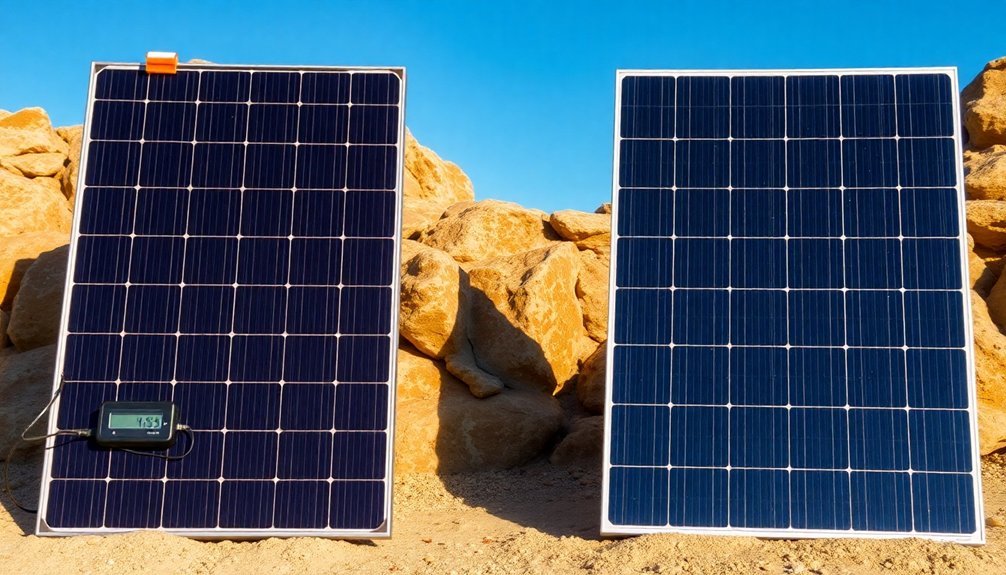
While solar panels may seem complex at first glance, their basic components and operation are straightforward.
You'll find that panels consist of individual solar cells that convert sunlight into DC electricity, which your inverter then changes to AC power for home use.
You can choose between two main types of panels: monocrystalline and polycrystalline.
Monocrystalline panels, made from single silicon crystals, offer higher efficiency and more power per square foot.
Though polycrystalline panels are less efficient, they're often more budget-friendly. A proper racking system installation ensures your panels are securely mounted to your roof or ground system.
Your choice of inverter also matters – you can opt for a central inverter near your electrical panel or microinverters under each panel.
Microinverters work particularly well if you've got partially shaded areas, as they convert power independently rather than in a string system.
Seasonal Sun Ray Patterns
You'll notice significant differences in solar panel performance between summer and winter due to the sun's changing path across the sky.
Your panels receive more direct, intense rays during summer months when the sun travels higher overhead, while winter brings lower sun angles and less powerful rays.
Understanding these seasonal patterns helps you position your panels at ideal angles to capture the most sunlight throughout the year. Areas near the equator typically have less seasonal variation in their solar panel output compared to locations at higher latitudes.
Sun Path Affects Performance
As the Earth orbits the Sun, the changing path of sunlight throughout the year considerably impacts your solar cooking results.
You'll notice that the sun's position shifts seasonally, affecting both the intensity and angle of rays hitting your solar cooker. Understanding these patterns will help you achieve ideal cooking temperatures.
- At equinoxes, your cooker will receive consistent sunlight patterns as the sun rises due east and sets due west, making these periods perfect for establishing baseline performance.
- During winter months, you'll need to tilt your panels at steeper angles to compensate for the sun's lower position in the sky.
- If you're cooking in higher latitudes, you'll experience more dramatic seasonal variations, requiring frequent angle adjustments to maintain effective cooking temperatures.
The sun's path directly influences cooking times and temperatures, so you'll want to adjust your panel angles accordingly. The Earth's 23.5 degree tilt creates significant differences in sun paths between summer and winter, affecting how you'll need to position your solar cooker throughout the year.
Winter Versus Summer Rays
The dramatic shift between winter and summer sun rays greatly impacts your solar cooking performance.
In winter, you'll notice the sun traveling a shorter, lower path across the sky, with its rays striking your cooking surface at a reduced angle. The tilt of Earth's axis causes these dramatic seasonal changes in sun angle. This means the sun's energy spreads over a larger area, delivering less intense heat to your food.
Summer brings longer days with the sun traveling higher overhead, creating more direct angles that concentrate solar energy onto your cooking surface. You'll get more intense heat because the sun's rays aren't spread thin.
During spring and fall equinoxes, you'll experience intermediate sun angles and equal daylight hours, offering moderate cooking conditions.
Understanding these seasonal patterns helps you adjust your panel angles throughout the year to capture maximum solar energy for your recipes.
Location Impact On Panel Angles
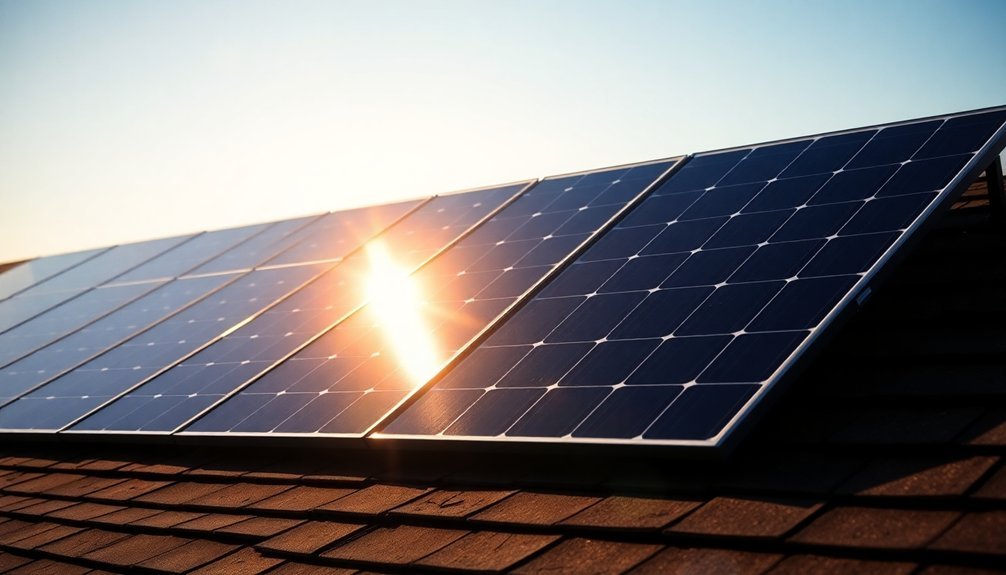
Geographic location fundamentally shapes your panel angles, with equatorial regions requiring flatter installations compared to polar areas where steeper angles maximize sun exposure.
You'll notice significant variations in ideal panel positioning as you move through different latitudes, with the sun's seasonal path becoming more dramatic at higher latitudes.
Your site's altitude also affects panel efficiency, as thinner atmosphere at higher elevations allows for more direct solar radiation and potentially different ideal angles than at sea level.
Equatorial Versus Polar Positions
Location plays an essential role in determining ideal solar panel angles, with striking differences between equatorial and polar positions.
You'll find that panels near the equator can be positioned almost flat, pointing directly upward to capture consistent, direct sunlight throughout the year.
In contrast, panels in polar regions require steep angles, nearly horizontal to the ground, to maximize exposure to the sun's lower path across the sky.
- At the equator, you'll achieve peak energy output with flat or slightly tilted panels due to direct overhead sunlight.
- In polar regions, you'll need steeper angles (almost horizontal) to capture the sun's rays effectively.
- Your location's latitude directly impacts the required tilt – the further from the equator, the steeper the angle needed for maximum energy production.
Seasonal Sun Path Variations
Building on these regional differences, you'll need to account for how the sun's path changes throughout the year. The sun's daily arc varies considerably between seasons, affecting how much sunlight your panels can capture for cooking.
In summer, you'll see higher, longer arcs, while winter brings shorter, lower paths across the sky.
For ideal heat generation, adjust your panel angles seasonally. A good rule of thumb is to set the tilt equal to your latitude, then add 15° in winter or subtract 15° in summer.
If you're in the Northern Hemisphere, aim your panels true south; if you're in the Southern Hemisphere, face them true north. You can make monthly adjustments for even better performance, but most cooks find seasonal changes sufficient for their needs.
Regional Altitude Effects
When cooking at higher altitudes, you'll notice significant improvements in your solar panel's performance due to increased solar radiation and cleaner air. Your panels will receive more direct sunlight because there's less atmospheric interference, and the cooler temperatures at elevation help maintain peak efficiency.
With fewer dust particles and pollutants in the air, you'll also experience better light transmission to your panels.
To maximize your solar cooking setup at high altitudes:
- Adjust your panel angles steeper than usual to compensate for latitude and prevent snow accumulation.
- Take advantage of the longer periods of direct sunlight by positioning panels to capture maximum radiation throughout the day.
- Consider the reduced air density and clearer skies when calculating ideal tilt angles for your specific location.
Setting Perfect Reflection Points
Setting the perfect reflection points in recipe photography requires a thorough understanding of the family of angles concept.
You'll need to position your light source carefully relative to your camera and subject to control reflection intensity.
To minimize harsh reflections, you can raise or lower your light source outside the family of angles.
Try using diffusers like white sheets or softboxes to soften the light on metal surfaces.
When working with shiny utensils, reposition them slightly or use museum putty to adjust their angles away from direct reflections.
For balanced lighting, place softbox lights slightly off-center and higher than your cooking area.
You can also bounce light using reflectors or aluminum foil to fill shadows.
If you're dealing with deep dishes, position your lights higher to eliminate unwanted shadows.
Heat Distribution Through Panels
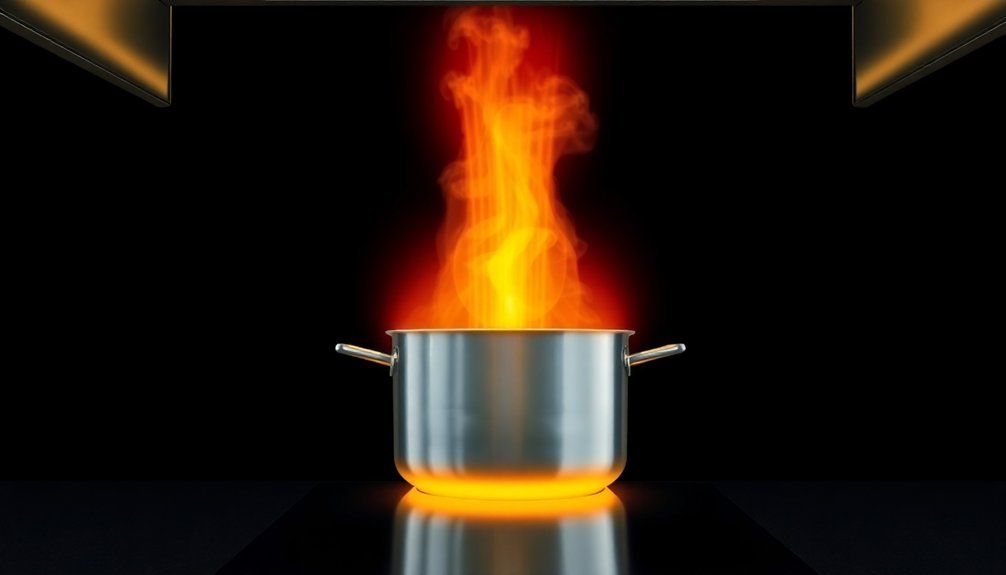
Proper heat distribution through panels relies heavily on understanding the three primary heat transfer mechanisms: conduction, convection, and radiation.
When you're working with panels, you'll need to take into account how their angles affect each type of heat transfer to maximize cooking efficiency. Material selection plays an essential role, as thermal conductivity and heat capacity determine how well your panels will distribute and maintain temperature.
- Position your panels to optimize radiant heat transfer, considering the surface emissivity and the Stefan-Boltzmann law principles.
- Configure panel angles to enhance natural convection flows, allowing heated air to circulate effectively throughout your cooking space.
- Guarantee proper contact between panels and cooking surfaces to maximize conductive heat transfer, especially when using high thermal conductivity materials like stainless steel.
Common Angle Adjustment Mistakes
Understanding panel angles builds upon heat distribution principles, but many cooks make preventable mistakes that compromise their results.
You'll find that overcrowding your cooking surface is one of the most common errors, leading to uneven heat and moisture buildup that prevents proper browning.
Another critical mistake is setting incorrect temperatures. If you're using heat that's too low, you won't achieve the desired Maillard reaction, especially when sautéing or browning proteins.
Not preheating your pan adequately can also cause food to stick and tear, particularly with stainless steel cookware.
You'll want to avoid rushing the cooking process. Let proteins develop their crust naturally before flipping, and don't overload the pan.
Remember to adjust heat settings based on what you're cooking and maintain consistent temperatures throughout.
Maximizing Cooking Temperature Control
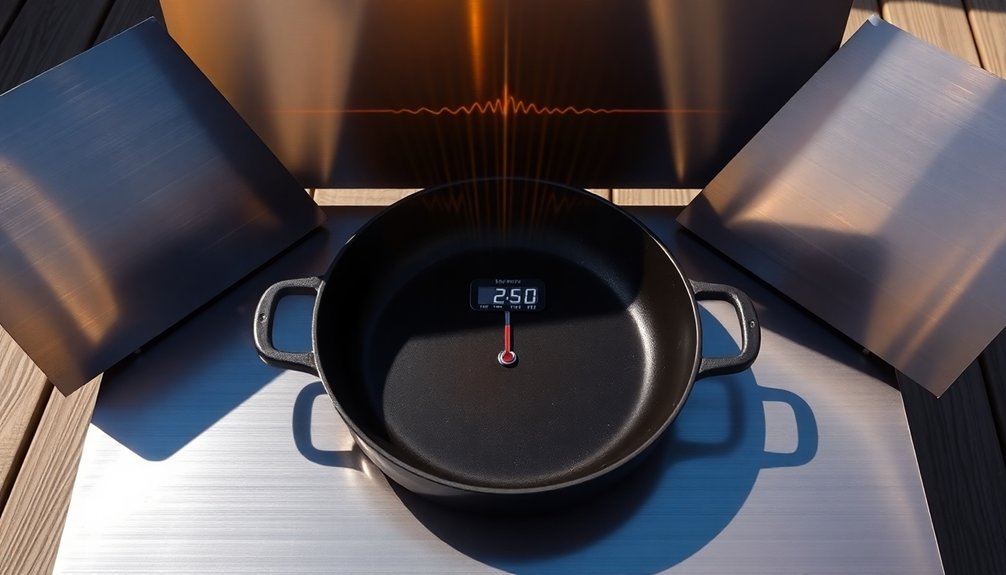
When you're aiming for perfect results in cooking, mastering temperature control becomes essential for consistent, high-quality dishes. Understanding how to adjust your vents and manage heat flow will greatly impact your cooking outcomes.
You'll need to match your vent settings to your desired cooking temperature, whether you're going for low-and-slow smoking or high-heat searing.
- For low-and-slow cooking (225-275°F), keep your bottom vent about 1-inch open and adjust the top vent accordingly.
- For mid-range temperatures (325-450°F), set your draft door halfway open to increase airflow.
- For high-heat cooking (500°F+), open both bottom and top vents fully to maximize air circulation.
Fine-tune your temperature control by monitoring your thermometer and making small adjustments to the Kontrol Tower top vent as you approach your target temperature.
Panel Material Selection Guide
Selecting the right cookware material can dramatically impact your recipe's success and cooking experience. Each material offers distinct advantages for different cooking methods and heat control needs.
Stainless steel provides excellent temperature control and won't react with acidic foods, making it ideal for delicate sauces.
If you're looking for a lighter alternative to cast iron, carbon steel offers similar benefits with easier handling.
Aluminum's superior heat conductivity makes it perfect for even cooking, while its affordability won't break your budget.
For specialized cooking, consider cast iron's unmatched heat retention for perfect searing, or copper's superior heat responsiveness for precise temperature adjustments.
While copper's expensive, its exceptional conductivity makes it a top choice for professional kitchens.
Cast iron requires more maintenance but rewards you with versatile cooking capabilities and lifetime durability.
Maintaining Optimal Heat Collection
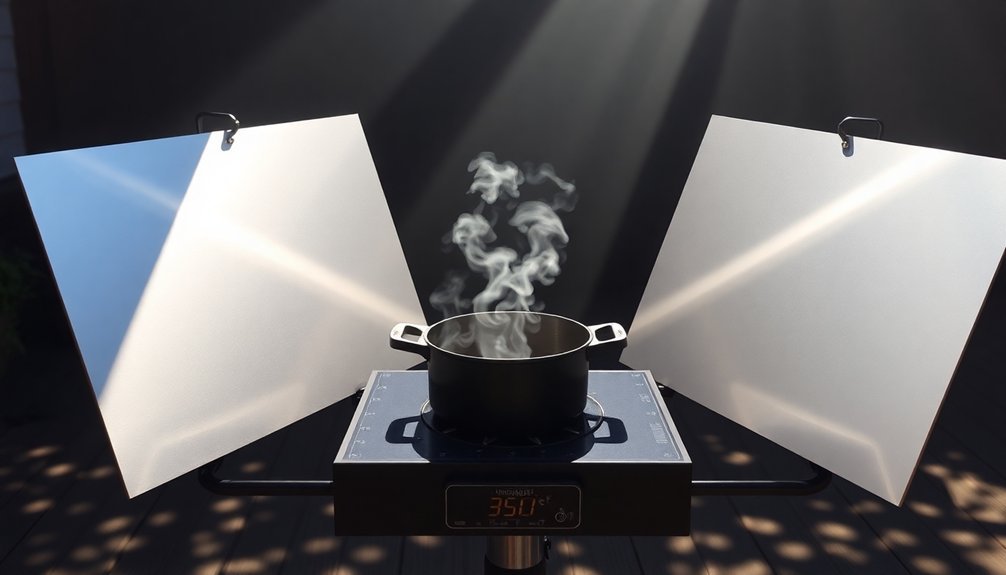
To maximize your solar panel's heat collection, proper positioning and angle adjustments play essential roles throughout the year.
You'll need to align your panels based on your hemisphere location – south-facing in the Northern Hemisphere and north-facing in the Southern Hemisphere. During peak heating hours, make sure your panels have unobstructed access to sunlight for peak performance.
- Set your panel's tilt angle to match your local latitude, but adjust it seasonally – reduce by 10-15 degrees in summer and increase up to 60 degrees in winter.
- Monitor shade patterns throughout the day and seasons, as even minimal shading can greatly reduce heat collection.
- Use online calculators or consult solar professionals to fine-tune your panel angles based on your specific location and energy needs.
Frequently Asked Questions
How Do Wind Conditions Affect the Required Panel Angles for Solar Cooking?
You'll need to adjust your panel angles to shield against wind while maintaining solar exposure. In high winds, you should lower the angles, while in calmer conditions, you can optimize purely for sun position.
Can Reflective Paint Improve Panel Performance Compared to Traditional Reflective Materials?
You'll get better performance from reflective paint on solar panels since it reflects up to 98.1% of sunlight versus traditional materials. It's also more durable and provides consistent reflection across the entire surface.
What Emergency Backup Methods Exist When Panel Angles Can't Be Adjusted?
You can use parabolic cookers, add booster panels, or employ oven roasting bags to retain heat. Try preheating food, positioning cookers on south-facing slopes, and using thermal mass like bricks for backup heating.
Do Atmospheric Pollution Levels Impact Optimal Panel Angle Calculations?
No, atmospheric pollution won't affect your best panel angle calculations. While pollution reduces overall efficiency, your ideal tilt angles still depend on latitude and sun position, not pollution levels. Keep focusing on maximizing sunlight exposure.
How Does Cooking Vessel Color Influence the Required Panel Angle Settings?
You'll need wider panel angles for black vessels since they absorb heat efficiently. With non-black vessels, set more acute angles to compensate for reduced absorption and focus extra sunlight onto the cooking surface.
In Summary
You'll find that proper panel angles make all the difference in your solar cooking success. By adjusting your panels seasonally and considering your location's solar patterns, you're able to capture maximum heat for consistent recipe results. Don't forget to maintain your panels and check angles regularly – these simple steps guarantee ideal heat collection and temperature control every time you cook with solar power.

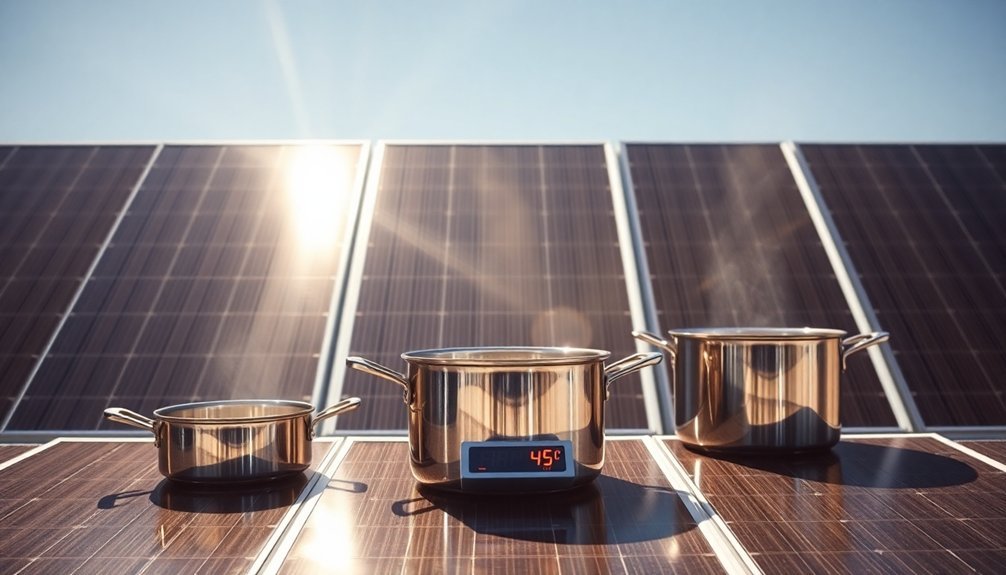



Leave a Reply